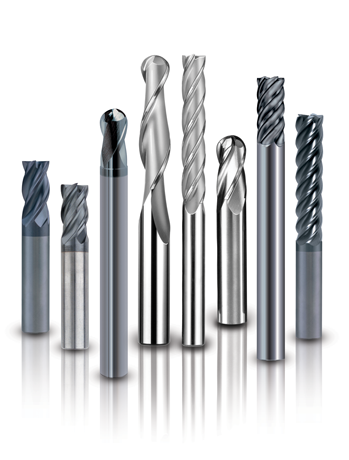
By geometry, there are many types of milling tools based on their geometry. Some of the most common for metal machining are:
Peripheral mills
Cylindrical cutters
Cut into the cylindrical periphery, producing flat surfaces parallel to the axis of the tool itself. Within them, you can find serrated, straight or helical ones.
- Type H: for steels, white-gray cast iron and non-ferrous metals. Mills with lengths exceeding 50 mm, the angles formed by the teeth are between 25º and 45º, to provide a more favorable entry impact and a uniform cut. The exit angle will be 12º.
- Type N: for hard and tough materials. It has parallel teeth to the axis of rotation with lengths of up to 19 mm. For higher sizes, the teeth have an angle of between 15º and 25º, while the angle of exit of the material is between 10º and 20º.
- Type W: for soft materials. It has parallel teeth to the axis of rotation with lengths of up to 19 mm. For larger sizes, they present angles between 15º and 25º. While the exit angle of the material is between 10º and 20º.
Roughing cutters
For cutting and removing chips. They have a slightly serrated edge.
Disc cutters: They have a short cutting length in relation to the diameter of the tool. Within them, they can be classified as.
- Disc with straight teeth.
- Disc with crossed teeth.
- Coupled discs (helical or flat).
- Double cut disc cutter.
Saws
They present a minimum length and are used for cutting. There are different types of metal saws, depending on the type of teeth: angular teeth (type A), curved teeth (type B) and stepped curved teeth (type C).
Shank type mills
They´re used for grooving, stamping, contours and recordings. They present a great versatility of uses (direction of cut, direction, opposite propeller or equal). Among the most representative types, you can find:
- Conical mills: flat or spherical tip and cylindrical or conical shank.
- Grooving cutters: with conical or cylindrical shank.
- T slots mills
- Woodruff milling cutter
Angular Mills
They are used for the machining of guides in angles, wedges and steel rules for workshop of different shape and edge.
- Face Mills: used to perform machining of guides at angles at 45, 50, 55 and 60 degrees.
- Prismatic mills: used to perform machining of prismatic guides at angles of 45, 60 and 90 degrees.
Constant profile mills
With or without shank. Its use is intended to achieve the specific geometric shape in the carved piece. They can be classified as:
- Convex end mills: used to make semicircular surfaces (semicircular grooves of radius from 1 to 20 mm).
- Concave end mills: used to make semicircular surfaces (semicircular grooves of radius from 0.5 to 20 mm).
- Modular mills: used to create gears, sprockets, pulleys, zippers, etc.

Recent Comments